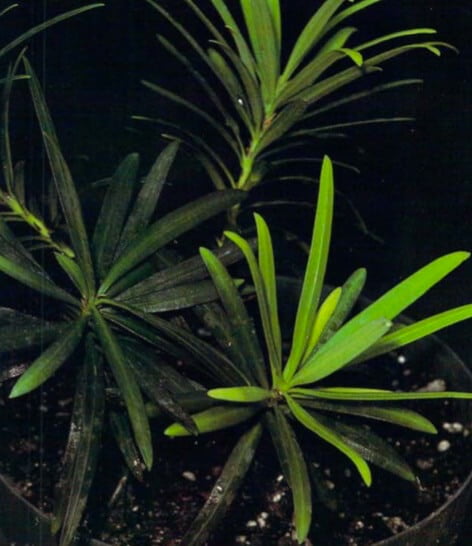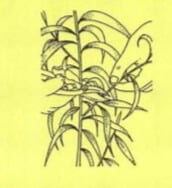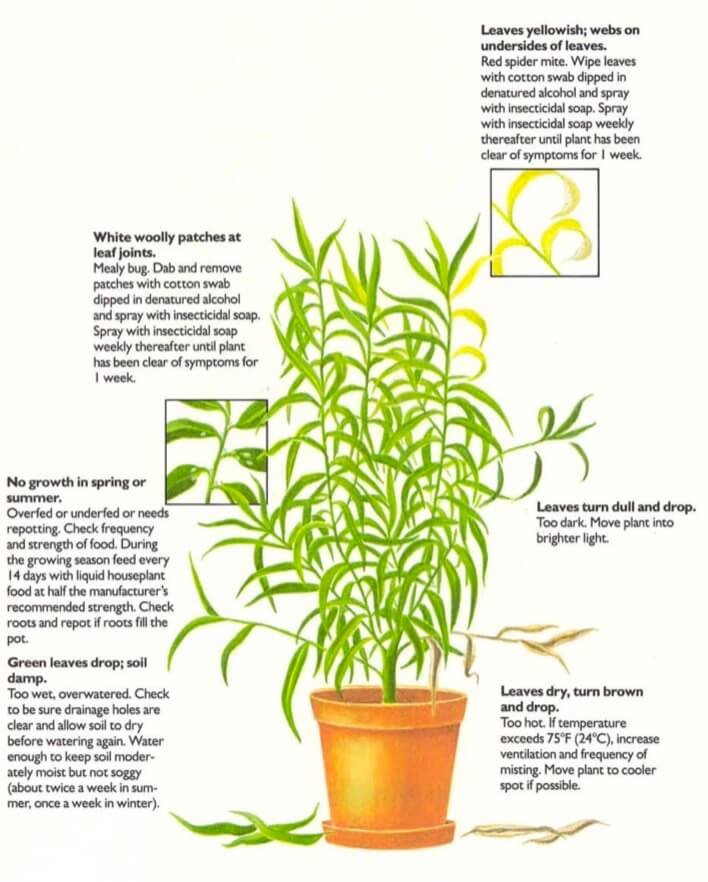[Ebook Việt Hoá] The Instant Guide to Healthy Houseplants (Hướng dẫn tức thời để chăm cây trong nhà khoẻ mạnh), Chi Podocarpus - Chi Thông Tre
[Ebook Việt Hoá] The Instant Guide to Healthy Houseplants: Podocarpus macrophyllus (Japanese yew)
- Nguồn: [Ebook Việt Hoá] The Instant Guide to Healthy Houseplants (Hướng dẫn tức thời để chăm cây trong nhà khoẻ mạnh)
- Biên tập: Dũng Cá Xinh
- Biên dịch: Team Codai.net
English
The Japanese yew is a tall tree in its native land. Grown as a houseplant, it is an elegant, somewhat delicate shrub that can be kept bushy by annual pruning. Flat, narrow leaves with bluish-green undersides grow on graceful branches. Older plants may produce cones that look like small cattails, but these rarely appear on plants kept indoors. Large plants need to be supported with a central stake.

Light
Provide bright light at all times.
Temperature
In winter, keep temperature above 45°F (7°C). In summer, plant does well at normal room temperatures; if temperature exceeds 75°F (24°C), provide good air circulation or put plant outside in a shaded location.
Water
Keep soil moderately moist at all times by watering twice a week in summer, once a week in winter. Do not allow pot to stand in water. Provide good drainage.
Soil
Use loam-based soil.
Feeding
While plant is growing in spring and summer, feed every 14 days with liquid houseplant food at half the manufacturer’s recommended strength.
Humidity
Mist once a week in winter, 2-3 times a week in summer, preferably in early morning. Full sunlight will burn leaves that have water droplets on them.
Repotting
Repot annually in spring when new growth starts. For large plants, replace topsoil only.
Cleaning
Misting should be sufficient. Leafshine may be used once a month.
Pruning
To keep plants bushy and compact, prune branches in spring or summer. Using sheers, cut at an angle just above a leaf.

What Goes Wrong

- No growth in spring or summer: Overfed or underfed or needs repotting. Check frequency and strength of food. During the growing season feed every 14 days with liquid houseplant food at half the manufacturer’s recommended strength. Check roots and repot if roots fill the pot.
- Green leaves drop; soil damp: Too wet, overwatered. Check to be sure drainage holes are clear and allow soil to dry before watering again. Water enough to keep soil moderately moist but not soggy (about twice a week in summer, once a week in Winter).
- Leaves dry, turn brown and drop: Too hot. If temperature exceeds 75°F (24°C), increase ventilation and frequency of misting. Move plant to cooler spot if possible.
- Leaves yellowish; webs on undersides of leaves: Red spider mite. Wipe leaves with cotton swab dipped in denatured alcohol and spray with insecticidal soap. Spray with insecticidal soap weekly thereafter until plant has been clear of symptoms for I week.
- White woolly patches at leaf joints: Mealy bug. Dab and remove patches with cotton swab dipped in denatured alcohol and spray with insecticidal soap. Spray with insecticidal soap weekly thereafter until plant has been clear of symptoms for 1 week.
- Leaves turn dull and drop: Too dark. Move plant into brighter light.
Tiếng Việt
Thủy tùng Nhật Bản là một loại cây cao trong số những cây địa phương. Được trồng như cây trong nhà, nó là một loại cây thanh lịch, có phần mỏng manh, có thể được trồng thành bụi bằng cách cắt tỉa hàng năm. Các lá phẳng, hẹp với mặt dưới màu xanh lục mọc trên các cành duyên dáng. Những cây già hơn có thể tạo ra những hình nón trông giống như những cái đuôi nhỏ, nhưng chúng hiếm khi xuất hiện trên những cây trồng trong nhà. Các cây lớn cần được hỗ trợ bằng cọc trung tâm.

Ánh sáng
Cung cấp ánh sáng sáng mọi lúc.
Nhiệt độ
Vào mùa đông, giữ nhiệt độ trên 45 ° F (7 ° C). Vào mùa hè, cây phát triển tốt ở nhiệt độ phòng bình thường; nếu nhiệt độ vượt quá 75 ° F (24 ° C), lưu thông không khí tốt hoặc đặt cây bên ngoài ở nơi có bóng râm.
Nước
Luôn giữ ẩm vừa phải cho đất bằng cách tưới nước 2 lần / tuần vào mùa hè, 1 lần / tuần vào mùa đông. Không để chậu đọng trong nước. Chuẩn bị hệ thống thoát nước tốt.
Đất
Sử dụng đất thịt.
Bón phân
Trong khi cây đang phát triển vào mùa xuân và mùa hè, cứ 14 ngày một lần bón cây với phân bón hữu cơ dạng lỏng với liều lượng một nửa so với khuyến nghị của nhà sản xuất.
Độ ẩm
Phun sương mỗi tuần một lần vào mùa đông, 2-3 lần một tuần vào mùa hè, tốt nhất là vào sáng sớm. Ánh sáng mặt trời đầy đủ sẽ làm cháy lá có các giọt nước ở trên.
Thay chậu
Thay chậu hàng năm vào mùa xuân khi cây mới bắt đầu phát triển. Đối với cây lớn, chỉ thay lớp đất mặt.
Làm sạch
Phun sương vừa đủ. Có thể sử dụng xịt bóng lá mỗi tháng một lần.
Cắt tỉa
Để giữ cho cây rậm rạp và gọn gàng, hãy cắt tỉa cành vào mùa xuân hoặc mùa hè. Dùng kéo cắt một góc ngay trên lá.

Những vấn đề có thể xảy ra

- Cây không phát triển vào mùa xuân hoặc mùa hè: Bón phân quá nhiều hoặc thiếu chất hoặc cần thay chậu. Kiểm tra tần suất và nồng độ của phân bón. Trong suốt mùa sinh trưởng, bón phân 14 ngày một lần với phân bón hữu cơ dạng lỏng với liều lượng một nửa so với khuyến cáo của nhà sản xuất. Kiểm tra rễ và thay chậu nếu rễ lấp đầy chậu.
- Lá xanh rụng; đất ẩm: Quá ẩm ướt, tưới quá nhiều. Kiểm tra để đảm bảo các lỗ thoát nước được thông thoáng và để đất khô trước khi tưới lại. Tưới vừa đủ ẩm cho đất nhưng không bị sũng nước (khoảng 2 lần / tuần vào mùa hè, 1 lần / tuần vào mùa đông).
- Lá khô, chuyển sang màu nâu và rụng: Quá nóng. Nếu nhiệt độ vượt quá 75 ° F (24 ° C), hãy tăng cường thông gió và tần suất phun sương. Di chuyển cây đến chỗ mát hơn.
- Lá hơi vàng; mạng nhện ở mặt dưới lá: Nhện đỏ. Lau lá bằng tăm bông nhúng cồn biến tính và xịt xà phòng diệt côn trùng. Phun xà phòng diệt côn trùng hàng tuần cho đến khi cây hết triệu chứng trong tuần thứ nhất.
- Các mảng len trắng ở các khớp lá: Rệp sáp. Chấm và loại bỏ bằng tăm bông nhúng vào cồn biến tính và xịt với xà phòng diệt côn trùng. Phun xà phòng diệt côn trùng hàng tuần cho đến khi cây hết triệu chứng bệnh trong 1 tuần.
- Lá chuyển sang màu xỉn và rụng: Quá tối. Di chuyển cây đến nơi sáng hơn.
![[Ebook Việt Hoá] The Instant Guide to Healthy Houseplants: Podocarpus macrophyllus (Japanese yew) [Ebook Việt Hoá] The Instant Guide to Healthy Houseplants: Podocarpus macrophyllus (Japanese yew)](https://vn1.vdrive.vn/codai.net/2020/02/ebook-huong-dan-tuc-thoi-cham-cay-trong-nha-khoe-manh-43-podocarpus-macrophyllus.jpg)


